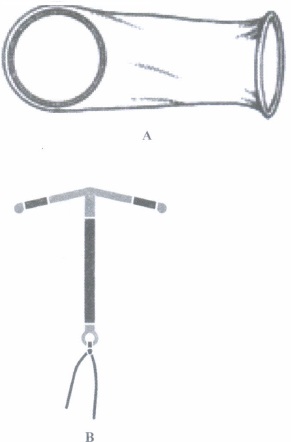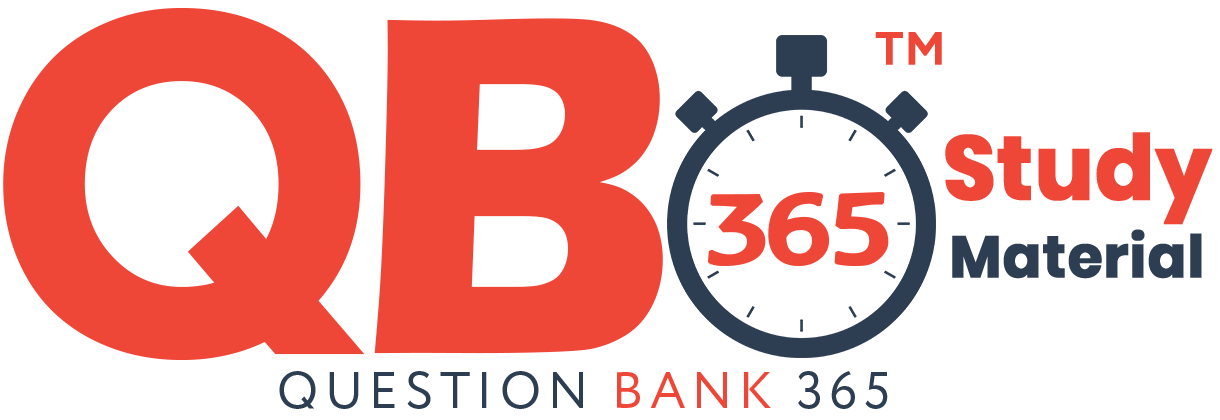CBSE 12th Standard Biology Subject Reproductive Health Case Study Questions 2021
By QB365 on 21 May, 2021
QB365 Provides the updated CASE Study Questions for Class 12 Biology, and also provide the detail solution for each and every case study questions . Case study questions are latest updated question pattern from NCERT, QB365 will helps to get more marks in Exams
QB365 - Question Bank Software
CBSE 12th Standard Biology Subject Reproductive Health Case Study Questions 2021
12th Standard CBSE
-
Reg.No. :
Biology
-

The picture shows two different contraceptive devices, used by human females.
(a) Identify A and B.
(b) Mention how each ofthem prevents fertilisation and conception.(a) -
Read the following and answer any four questions from (i) to (v) given below:
Intrauterine devices are most widely accepted methods of contraception. These are used by females and are inserted by doctor or nurses in the uterus through vagina. However these devices are not recommended for those who eventually intend to conceive.
(i) How does CuT prevent conception?(a) Cu ions make uterus unsuitable for implantation (b) Cu ions make cervix hostile to the sperms (c) Cu ions suppress sperms motility (d) Cu ions inhibit ovulation (ii) Which of the following IUDs makes uterus unsuitable for implantation?
(a) LNG-20 (b) Multiload 375 (c) Cu7 (d) Lippes loop (iii) Identify the correct statement for IUDs,
(a) They slowly release synthetic progesterone in the body. (b) They increase phagocytosis of sperms within the uterus (c) They block entry of sperms through the cervix. (d) Both (b) and (c) (iv) Select the correct matched pair.
(a) Hormone releasing IUD - LNG-20 (b) Non-medicated IUD - Progestasert (c) Copper releasing IUD - Lippes loop (d) None of these (v) Assertion : IUDs can cause excess menstrual bleeding and pain.
Reason : IUD s can perforate uterus.(a) Both assertion and reason are true and reason is the correct explanation of assertion. (b) Both assertion and reason are true but reason is not the correct explanation of assertion (c) Assertion is true but reason is false (d) Both assertion and reason are false. (a) -
Read the following and answer any four questions from (i) to (v) given below:
A technique knowa as amniocentesis is used to determine fetal abnormalities. This test is based on the chromosomal pattern in amniotic fluid. However, this technique is legally banned now.
(i) Identify X and Y in the above given figure.X y (a) Amnion Chorion (b) Uterine wall Placenta (c) Placenta Uterine wall (d) Uterine wall Amnion (ii) What is the function of Z?
(a) Z is an amniotic fluid which prevents dessication of an embryo. (b) Z is yolk sac which functions as site of early blood cell formation (c) Z is amnion which takes part in placenta formation. (d) None of these (iii) Which of the following diseases can not be diagnosed by amniocentesis?
(a) Down's syndrome (b) Sickle cell disease (c) Jaundice (d) Cystic fibrosis (iv) Assertion: Amniocentesis is legally banned for sex determination.
Reason: Amniocentesis was being misused for aborting normal female fetus(a) Both assertion and reason are true and reason is the correct explanation of assertion (b) Both assertion and reason are true but reason is not the correct explanation of assertion (c) Assertion is true but reason is false. (d) Both assertion and reason are false. (v) Which of these is a non-invasive technique of detecting fetal disorder?
(a) Fetoscopy (b) Chorionic villi sampling (c) Amniocentesis (d) Ultrasound imaging (a) -
Read the following and answer any four questions from (i) to (v) given below:
Rohan, a 13 year old school student has been diagnosed with AIDS. He often complains of fever, nausea, headache and lethargy. Doctor advised some drugs to prolong his life.
(i) What could be the most likely mode of transmission of disease to Rohan?(a) Artificial insemination (b) Sexual intercourse with infected partner (c) From injected mother through placenta (d) Use of contaminated blade (ii) Name the drug prescribed for treatment of this disease.
(a) Zidovudine (b) Taxol (c) Vinblastine (d) Both (a) and (c) (iii) Assertion: AIDS is an incurable STD.
Reason : AIDS virus attacks helper T-Lymphocytes(a) Both assertion and reason are true and reason is the correct explanation of assertion. (b) Both assertion and reason are true but reason is not the correct explanation of assertion (c) Assertion is true but reason is false (d) Both assertion and reason are false. (iv) AIDS cannot be diagnosed by
(a) ELISA (b) PCR (c) Western blotting (d) VDRL (v) AIDS can be transmitted, by
(a) sharing towels (b) kissing (c) sharing contaminated needles (d) all of these (a) -
Read the following and answer any four questions from (i) to (v) given below:
Oral administration of small doses of hormones is contraceptive method used by the females. They are used in the form of tablets and hence called the pills. The oral pills are two types; mini pills and combined pills.
(i) Mini pills contain(a) estrogen only (b) progestin only (c) combination of progesterone estrogen (d) inhibin. (ii) How do hormonal pills prevent pregnancy?
(a) By phagocytosing the sperms (b) By inhibiting ovulation (c) By preventing sperms from entering the vagina (d) All of these (iii) Pill containing non-steroidal preparation, centchroman is
(a) Mala D (b) Mala N (c) i-Pill (d) Saheli (iv) Which among the following is incorrect for oral contraceptives?
(a) Oral pills alter the uterine endometrium and make it unsuitable for implantation. (b) Oral pills have to be taken daily for 7 days starting within first five days of menstrual cycle. (c) Oral pills increase the risk of intravascular clotting. (d) Oral pills contain either progestin alone or combination of progestogen and estrogen. (v) Assertion : Mala D, a combined contraceptive pill have to be taken daily without a break.
Reason : Mala D contains synthetic progesterone and estrogen.(a) Both assertion and reason are true and reason is the correct explanation of assertion. (b) Both assertion and reason are true but reason is not the correct explanation of assertion. (c) Assertion is true but reason is false (d) Both assertion and reason are false (a)
Case Study Questions
*****************************************
CBSE 12th Standard Biology Subject Reproductive Health Case Study Questions 2021 Answer Keys
-
(a) A - Condom; B - Copper T
(b) (i) A is a barrier that prevents the entry of sperms (semen) into the reproductive tract and prevents meeting of sperm and ovum for fertilisation.
(ii) The Cu2+ released by B suppress sperm motility and thereby the fertilising capacity of sperms.
-
(i) (c) : Cu ions suppress motility and fertilising capacity of sperms.
(ii) (a) : Hormone releasing IUDs (progestasert, LNG-20) make the uterus unsuitable for implantation and the cervix hostile to the sperms.
(iii) (b)
(iv) (a) : Lippes loop is a non-medicated IUD and progestasert is a hormone releasing IUD.
(v) (b) -
(i) (b)
(ii) (a)
(iii) (c) : Amniocentesis is a fetal disorder test based on the chromosomal pattern in the amniotic fluid surrounding the developing embryo. It detects genetic disorders like Down syndrome, sickle cell anaemia
and cystic fibrosis.
(iv) (a)
(v) (d) : Non invasive techniques are available to determine the fetal condition. These techniques do not pose any risk to fetus. Ultrasound imaging is a non-invasive technique. -
(i) (d)
(ii) (a) : There is no cure of AIDS, however use of certain drugs can prolong the life of AIDS patients.
E.g., Zidovudine, Didanosine.
(iii) (b)
(iv) (d) : AIDS can be diagnosed by ELISA test and western blotting test. Western blotting test is used for confirmation of ELISA positive cases. PCR is also used to diagnose AIDS. VDRL (Venereal Disease Research Laboratory) is not used to detect AIDS.
(v) (c) : Virus of AIDS is transmitted via blood and semen. -
(i) (b) : Mini pills contain progestin only with no estrogen.
(ii) (b) : Oral contraceptive pills inhibit ovulation and implantation.
(iii) (d) : Saheli contains non-steroidal preparation called centchroman.
(iv) (b) : Oral pills have to be taken daily for 21 days starting within first five days of menstrual cycle.
(v) (b)
Case Study Questions






































